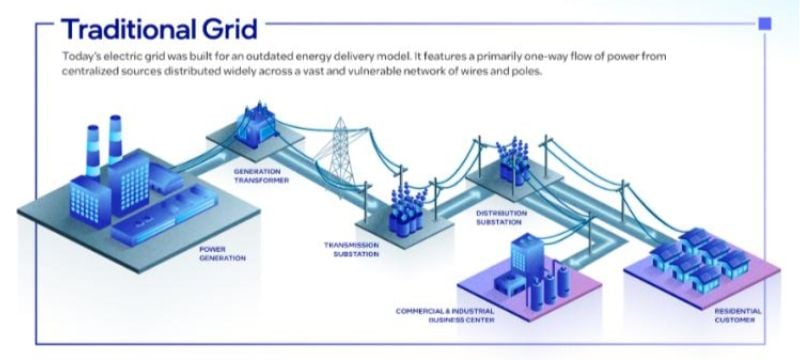Intel Uses AI to Rethink Power Grid Infrastructure
By moving away from a one-way power flow, Intel’s grid concept can help support the integration of renewables.
As renewable energy sources emerge nationwide, the existing grid infrastructure faces a problem. Originally designed to support centralized energy production, such as from a power plant, the legacy infrastructure is not well equipped to handle the integration of renewables like wind and solar, which generate power at decentralized locations.
Transmission tower. Image used courtesy of Pixabay
To address this challenge, Intel has joined an initiative with the Edge for Smart Secondary Substations (E4S) Alliance to build a new paradigm in grid infrastructure. What ideas does Intel bring to the table?
Traditional Grid and One-Way Power Flow
A defining characteristic of conventional electrical grids is that they have been designed to accommodate a one-way energy flow.
This traditional structure was designed with a central paradigm: electricity is generated in large power plants for transmission over long distances to consumers. When these systems were developed, the primary sources of power generation were large-scale facilities like coal, gas, and nuclear power plants, which provide a steady and predictable flow of electricity. The electricity journey in these grids is linear, starting from generation through high-voltage transmission lines, stepping down through various substations, and eventually reaching end-users via low-voltage distribution networks.
Traditional grids feature a primarily one-way flow of power. Image used courtesy of Intel
However, this structure does not hold up in today’s renewable energies and decentralized power generation world. Power cannot flow from the consumer to the grid in a one-way system. This limitation becomes increasingly problematic with the rise of distributed generation sources, where excess energy generated by consumers could be fed back into the grid. Additionally, the intermittent nature of renewables like solar and wind energy clashes with the rigidity of traditional grid architecture, leading to underutilization of renewable energy and difficulties in maintaining a consistent power supply.
Finally, the one-way flow system challenges load balancing and grid stability. With the increasing demand for electricity and the introduction of high-power-consuming devices, the grid is often strained, leading to inefficiencies and potential power outages. The linear structure also lacks the sophistication to efficiently manage fluctuations in power demand, further exacerbating these challenges.
Intel’s Modernized Grid
To resolve this issue, Intel, in collaboration with the Edge for Smart Secondary Substations (E4S) Alliance, is presenting a shift in how energy grids function. Specifically, the initiative aims to transform the traditional one-way, rigid power system into a flexible, software-defined energy network.
One of the key aspects of this modernized grid is its ability to handle the inherent intermittency of renewable energy sources. By incorporating Intel's hardware, software, artificial intelligence (AI), and communication technology at the substation level, the grid becomes more adaptable, effectively managing and integrating renewable energy when available.
Intel’s vision of a modernized grid. Image used courtesy of Intel
Intel’s technology, including Intel Core processors, brings AI and Internet of Things capabilities into the grid's infrastructure to enable real-time decision-making at the grid's edge, optimize energy source selection, and enhance the grid's ability to accommodate renewable and intermittent clean energy sources. This level of dynamic operation is a significant departure from the traditional grid's static nature, showcasing a future where data analytics, weather predictions, and maintenance schedules can be seamlessly integrated for efficient grid management.
Addressing World Energy Challenges
As Intel and the E4S Alliance continue field trials through 2024 and aim for global adoption, the significance of this technological leap becomes apparent. The shift from a traditional one-way grid to a dynamic, intelligent network marks a critical step in addressing the modern world's energy challenges. Additionally, the environmental impacts could be big. Intel’s estimates suggest that implementing this solution in a single substation could have an environmental benefit equivalent to removing up to 1,800 gasoline-powered cars from the road.









